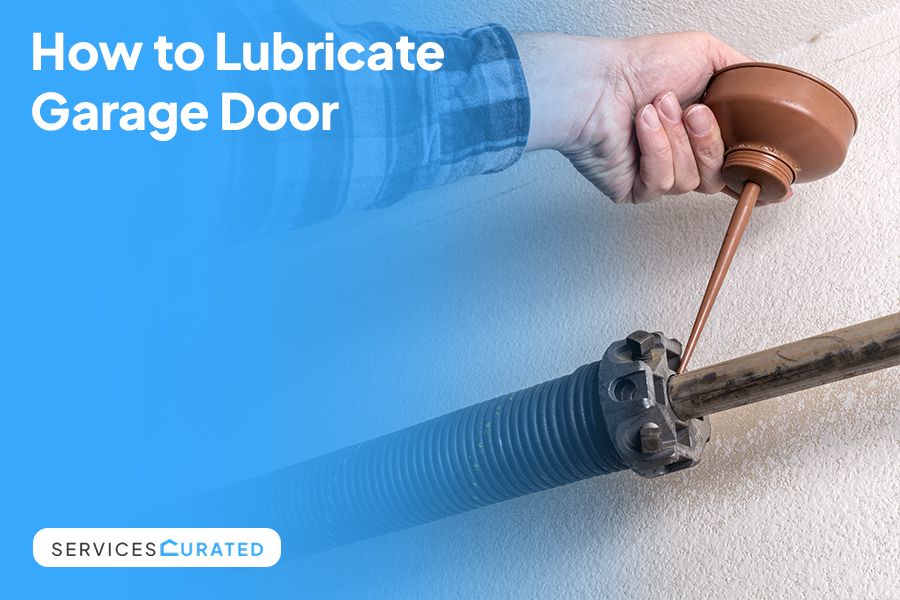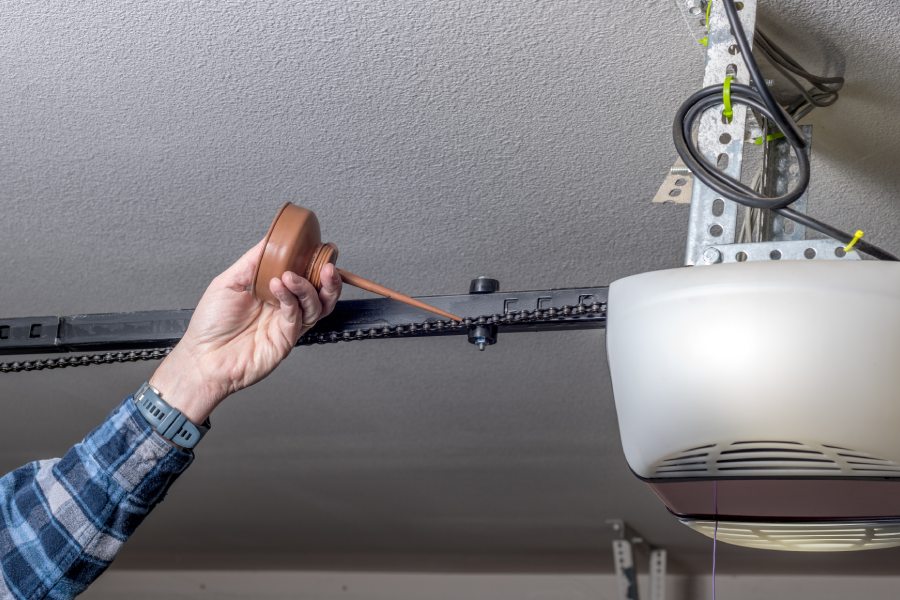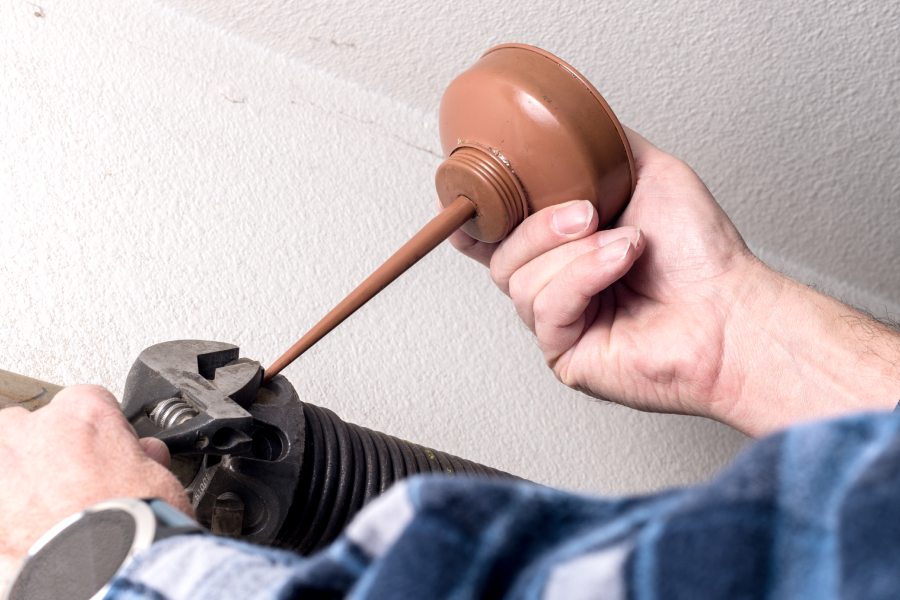How to Lubricate Garage Door

A well-maintained garage door is more than just a convenience; it’s an essential component of your home’s security and functionality. Among the various aspects of garage door upkeep, proper lubrication stands out as a critical yet often overlooked task. Regular lubrication not only ensures smooth operation but also extends the lifespan of your garage door’s moving parts, saving you money on repairs and replacements in the long run.
In this comprehensive guide, we’ll explore how to lubricate garage doors and the importance of lubricating them. We’ll also provide you with expert tips to keep them operating seamlessly.
Whether you’re a seasoned DIY enthusiast or a first-time homeowner, understanding the basics of garage door maintenance can make a significant difference in your daily life. So, let’s dive into the world of garage door care and discover how a little lubrication can go a long way in preserving this vital home feature.

How to Lubricate Garage Door
Regular garage door lubrication is crucial for smooth operation. It reduces noise, minimizes wear on moving parts, extends the door’s lifespan, and prevents expensive repairs. Follow these step-by-step instructions to keep your garage door working well:
- Gather necessary tools and supplies
First, gather what you need: a silicone-based lubricant or lithium grease, a clean cloth, and a step ladder. Ensure your lubricant is suitable for garage doors, as some can attract dirt, which is harmful to the door. Wear safety glasses and gloves for protection.
Having all your tools ready will make the job easier and faster. Consider getting a flashlight to better see dark corners and a small brush to clean tight spots before lubricating.
- Clean the garage door components
Before you start, clean the door parts. Use a cloth to wipe away dirt and old grease, as this helps the new lubricant work better. Pay special attention to the tracks and rollers, which often collect the most dirt. Use a brush to remove stubborn grime, and ensure all parts are dry before applying new lubricant.
While cleaning, look for any signs of rust or damage. If you spot any issues, address them before lubricating. This thorough cleaning process will ensure optimal performance and extend the lifespan of your door mechanism. Now, where to lubricate garage door? Let’s find out!
- Lubricate the hinges
Begin with the hinges, applying lubricant to the moving parts, especially the pivot points where the hinge bends. These areas require the most attention. Use only a small amount of lubricant, as a little goes a long way.
Wipe off any excess to prevent drips. Move the door up and down to work the lubricant into the hinges, and listen for any squeaking sounds that might indicate you missed a spot.
- Lubricate the rollers
Next, lubricate the rollers by applying some lubricant to the roller stems and a thin layer on the tracks they move in. Be careful not to get lubricant on the roller wheels, as this can cause them to slip.
For nylon rollers, use less lubricant since they don’t need as much as metal rollers. After lubricating, check if the rollers spin freely. If they don’t, they might need to be replaced soon.
- Lubricate the springs
For the springs, apply lubricant along their length. Be cautious, as springs can be dangerous. If you have torsion springs, spray lubricant evenly along the coil. For extension springs, focus on the pulley.
If you’re not comfortable with this step, it’s advisable to call a professional. Check for any signs of wear or rust on the springs, as damaged springs can be extremely dangerous and should be replaced by a professional.
- Lubricate the tracks
Begin by cleaning the tracks thoroughly. Once they’re clean, apply a thin layer of lubricant and wipe off any excess, as too much lubricant can cause the rollers to slip. Use your finger to spread the lubricant evenly in the tracks to ensure smooth movement.
Clean tracks will help your door open and close more quietly. While lubricating, also check the alignment of the tracks. Misaligned tracks can lead to problems and should be adjusted. Regular maintenance will help prevent future operational issues.
- Lubricate the locks and arm bar
Lubricate the locks and the arm bar that connects to the opener. Put some on the moving parts of the lock and the arm bar’s joints, as well as the keyhole if your door has one. A well-lubricated lock is easier to use.
Lubricating the arm bar reduces strain on your opener motor. Check that the lock engages smoothly after lubricating. If it doesn’t, you might need to clean it more thoroughly or consider replacing it.
- Test the garage door
Test the door by opening and closing it a few times to distribute the lubricant evenly. Listen for any odd noises; if you hear anything unusual, check that part again. Watch how the door moves – it should go up and down smoothly.
If it doesn’t, you might need to adjust something or add more lubricant. Test the door’s balance by disconnecting the opener and lifting it manually; it should stay in place when you let go halfway up.
Regular maintenance like this keeps your garage door operating smoothly for a long time. Aim to lubricate your door every six months to prevent wear and tear and catch potential problems early. Keep a record of when you lubricate the door to remind yourself when it’s time to do it again.
How Often to Lubricate Garage Door
Most experts recommend lubricating your garage door every six months to maintain smooth operation and prevent wear and tear. However, several factors can influence this frequency, such as climate, usage, and the age of your door. Doors in humid or dry areas may need more frequent lubrication, and those used multiple times daily might require additional attention.
Pay attention to signs like unusual noises, jerky movements, or visible rust, and adjust the lubrication schedule based on these indicators. Regular maintenance helps prevent long-term damage and ensures consistent performance. Always refer to your door’s manufacturer guidelines for specific recommendations.

Conclusion
Proper lubrication is crucial for maintaining a well-functioning garage door. By following the steps outlined in this guide, you can ensure your door operates smoothly and quietly while extending its lifespan. Remember to gather tools, clean well, lubricate, and inspect all moving parts.
Understanding how to lubricate garage door properly is a valuable skill for any homeowner. Regular maintenance, typically every six months, can prevent costly repairs and keep your garage door in top condition.
However, factors like climate, usage frequency, and the door’s age may necessitate more frequent lubrication. Always be attentive to signs of wear and tear, such as unusual noises or jerky movements. With regular care, your garage door will remain a reliable home entry.
